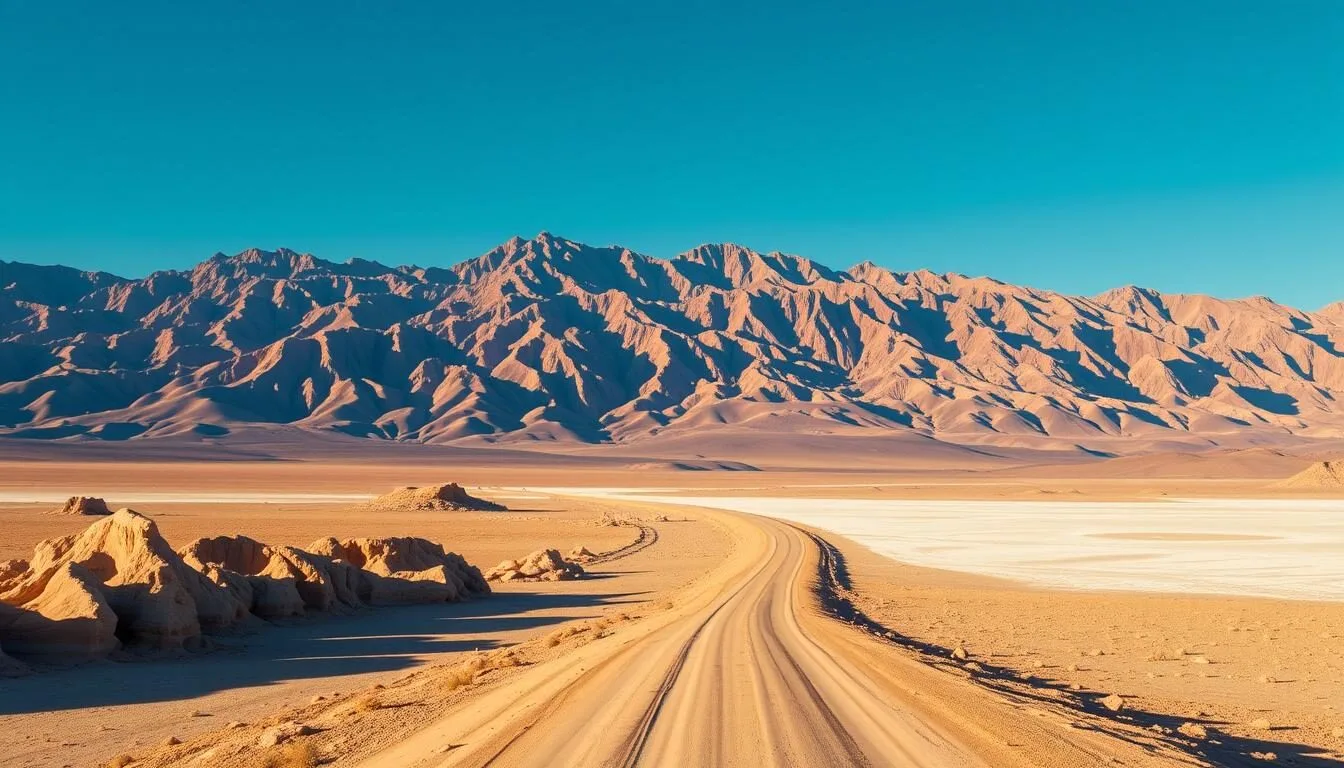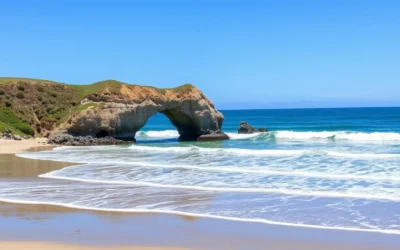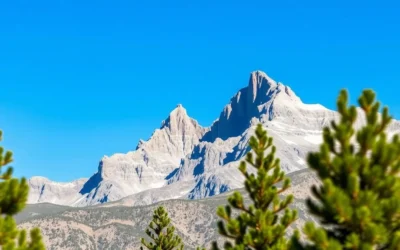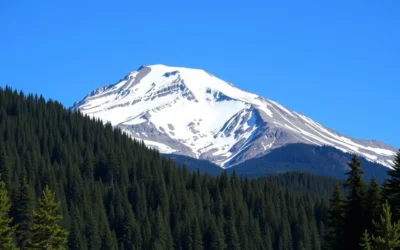✓ Accommodations✓ Flights✓ Rental Cars
Did you know that Death Valley National Park holds the record for the hottest temperature on Earth, reaching a scorching 134°F (56.7°C) in 1913? This extreme climate is just one aspect of the park’s unique charm.
As you explore this vast desert landscape, you’ll encounter a diverse range of landscapes, from the lowest point in North America to stunning viewpoints and geological wonders. With its salt flats, sand dunes, colorful canyons, and surprising waterfalls, Death Valley offers an unforgettable experience.
Whether you’re planning a day trip or a multi-day adventure, this guide will help you prioritize the best things to do in this remarkable park.
Discovering Death Valley National Park: An Overview
Spanning over 3.4 million acres, Death Valley National Park is a vast and varied landscape that promises an exciting journey. As the largest national park in the contiguous United States, it offers a diverse range of landscapes and ecosystems to explore, from the lowest point in North America at Badwater Basin to the towering Telescope Peak.
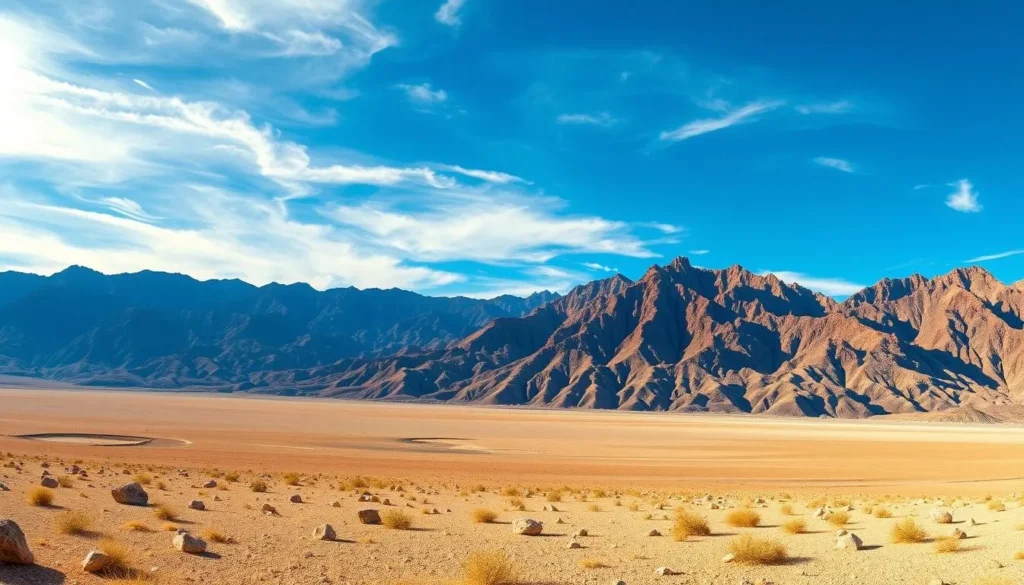
The Extremes of Death Valley
Death Valley is renowned for its extreme conditions. It holds the record for the hottest temperature ever recorded on Earth, reaching a scorching 134°F (57°C) at Furnace Creek on July 10, 1913. The park’s vast desert landscapes are as beautiful as they are unforgiving, with limited water resources and remote areas that see little foot traffic.
| Extreme Feature | Description | Location |
|---|---|---|
| Hottest Temperature Recorded | 134°F (57°C) | Furnace Creek |
| Lowest Point in North America | 282 feet below sea level | Badwater Basin |
| Tallest Peak | 11,049 feet | Telescope Peak |
Best Times to Visit Death Valley
When planning your visit to Death Valley National Park, timing is crucial. Spring (March-April) is considered the best time to visit when temperatures are moderate and wildflowers may bloom. Winter (November-February) offers comfortable daytime temperatures ideal for hiking. In contrast, summer visits (May-September) require extreme caution due to the dangerous heat, limiting activities to early morning or evening.
Visiting Death Valley during the recommended seasons ensures a safer and more enjoyable experience. With proper preparation, including plenty of water and sun protection, you can fully appreciate the park’s vast and unique landscapes.
Planning Your Death Valley Adventure
Before heading to Death Valley, understanding how to get there, how long to stay, and what to pack is essential for a memorable experience. Death Valley National Park, located in south-central California on its eastern border with Nevada, is a unique destination that requires careful planning.
How to Get to Death Valley National Park
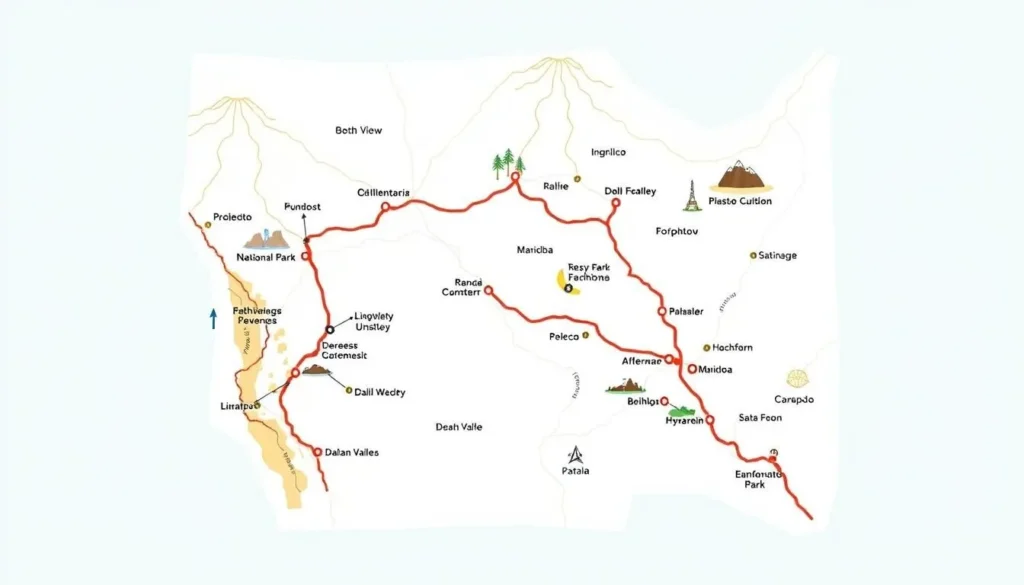
Death Valley National Park is accessible from multiple directions. From Los Angeles, it’s roughly 266 miles, a drive of about 5 hours. From Las Vegas, the distance ranges from 111 to 142 miles, depending on your route, with a drive time of about 2 hours. You can access the park from various entry points, with the most common being from Las Vegas or Los Angeles.
How Many Days to Spend in Death Valley
For your Death Valley adventure, plan to spend at least 2-3 days to experience the major highlights without rushing. Although a day trip is possible if you’re limited on time, staying longer allows you to appreciate the park’s vast landscapes and extreme conditions fully.
Essential Items to Pack
Packing the right items is crucial for a safe and enjoyable trip to Death Valley. Essentials include plenty of water (at least one gallon per person per day), sun protection (hat, sunscreen, sunglasses), a detailed map, snacks, and a full tank of gas. Given the extreme temperature variations, pack layers, and if you plan to hike, include proper footwear, hiking poles, and a first aid kit.
Badwater Basin: The Lowest Point in North America
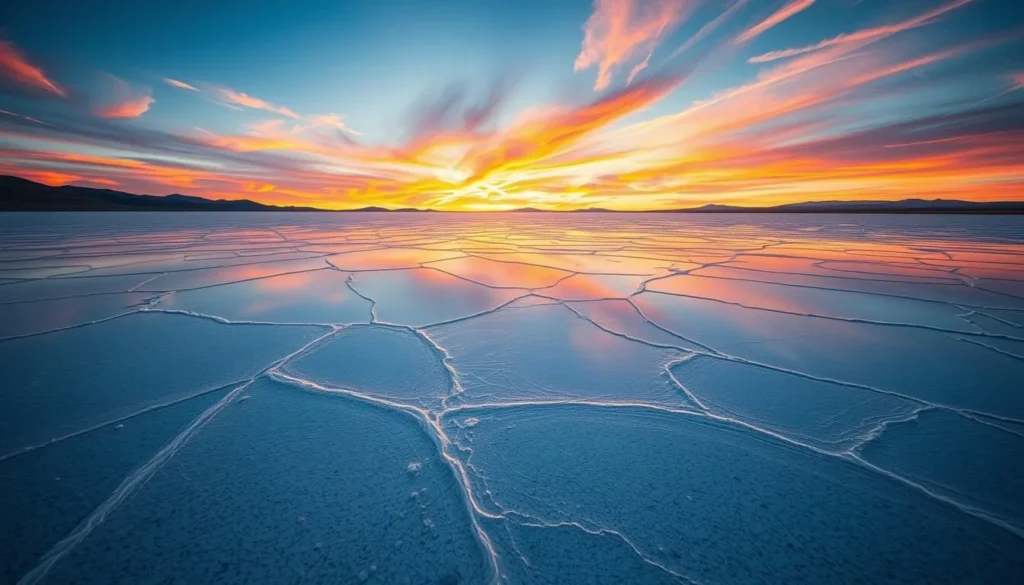
Standing at 282 feet below sea level, Badwater Basin is an otherworldly location that offers a unique experience. As you visit Death Valley National Park, a trip to Badwater Basin is a must. From the parking lot, a wide, flat trail heads out into the salt flats, creating a surreal landscape of crystalline white polygons.
Walking on the Salt Flats
At Badwater Basin, you’ll stand at the lowest point in North America, marked by a sign indicating this remarkable geographical extreme. The vast salt flats stretch out before you. For the best experience, walk at least half a mile out onto the salt flats to escape the crowds near the boardwalk.
Photography Tips for Badwater Basin
Photography is spectacular here, especially during sunrise or sunset when the low angle of light creates dramatic shadows across the salt polygons. The basin is located 17 miles south of Furnace Creek. A visit here can last 30 minutes or longer, depending on how far you walk and how creative you get with your photography.
Badwater Basin is a unique spot that is 282 feet below sea level, making it an unforgettable experience. Whether you’re a photographer or just a curious visitor, Badwater Basin in Death Valley is a must-see destination.
Mesquite Flat Sand Dunes: Desert Playground
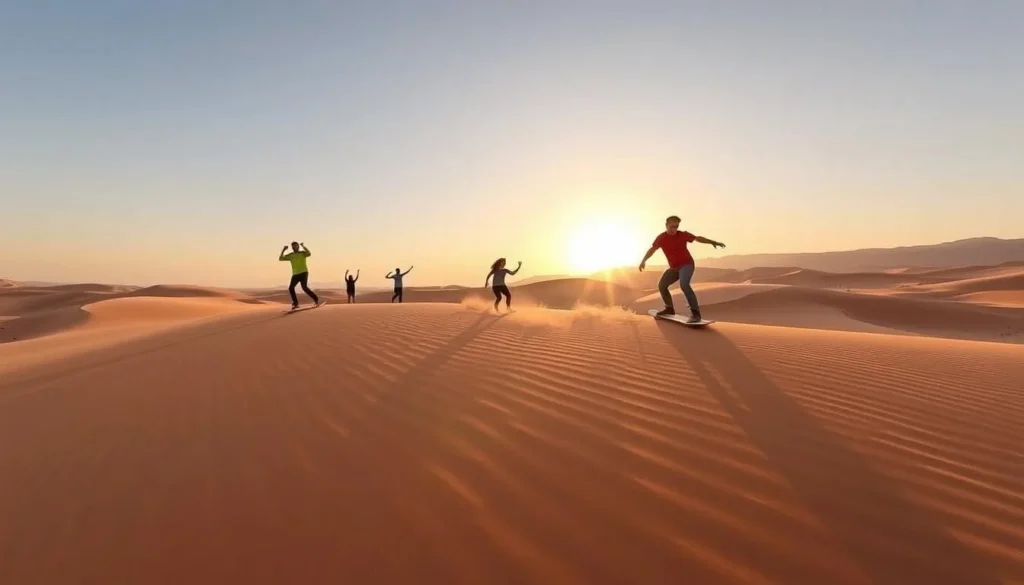
Mesquite Flat Sand Dunes offer a distinct experience for every visitor, from casual wanderers to thrill-seekers. Located 22 miles northwest of Furnace Creek along Highway 190, this accessible destination is a must-visit in Death Valley National Park.
The dunes rise approximately 100 feet from the desert floor, creating a stunning landscape of rippling sand. The best lighting conditions for photography are at sunrise or sunset when the low angle of the sun creates dramatic shadows and highlights the textures of the dunes.
Best Times to Visit the Dunes
Early morning is the ideal time to visit the Mesquite Flat Sand Dunes, not only for photography but also to see animal tracks in the pristine sand and enjoy cooler temperatures before the heat of the day.
Activities at Mesquite Flat Sand Dunes
Visitors can enjoy various activities at the dunes, including sandboarding, photography, stargazing, and simply wandering through this otherworldly landscape. The highest dunes are about 1.5 miles from the parking area, requiring a moderate hike through soft sand.
Whether you’re looking for adventure or a serene experience, Mesquite Flat Sand Dunes in Death Valley are a unique playground that offers something for everyone.
Zabriskie Point: Iconic Death Valley Views

With its panoramic views of golden badlands and salt flats, Zabriskie Point is an unforgettable experience in Death Valley. The viewpoint is easily accessible via a short paved path from the parking area, making it one of the most convenient spectacular vistas in the park.
Sunrise and Sunset at Zabriskie Point
Sunrise is particularly magical at Zabriskie Point as the first light of day creates dramatic shadows and highlights the vibrant colors of the badlands. However, you should arrive early as the parking lot fills quickly.
The same applies to sunset, where the fading light casts a warm glow over the landscape, creating a serene atmosphere.
Hiking Opportunities from Zabriskie Point
From Zabriskie Point, you can access several hiking trails, including the moderate Golden Canyon-Gower Gulch Loop (7.5 miles) that takes you through the heart of the badlands.
The area around Zabriskie Point was formed by ancient lake sediments that were uplifted and eroded over millions of years, creating the distinctive yellow and brown mudstone formations you see today.
Artists Drive and Artists Palette: Nature’s Canvas
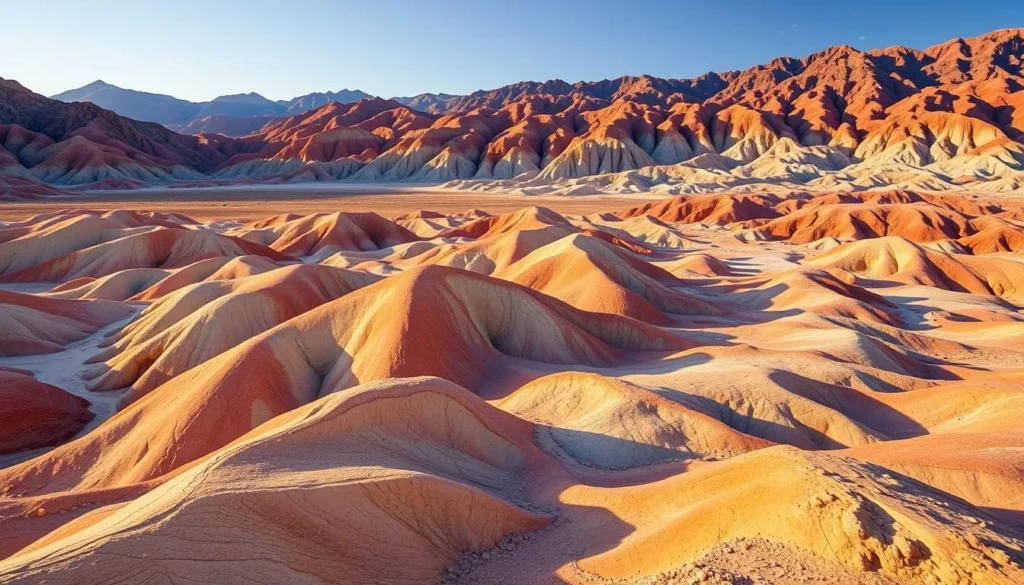
Death Valley’s Artists Drive is a breathtaking 9-mile scenic route that showcases the park’s unique geological formations. This one-way drive winds through multi-colored hills and canyons, offering a visual feast for visitors. As you drive along Artists Drive, you’ll be treated to a kaleidoscope of colors.
The Science Behind the Colors
The vibrant colors at Artists Palette, a highlight of the drive, are created by the oxidation of different metals in the volcanic deposits. Red and pink hues come from iron oxides, while green is derived from decomposing tuff-derived mica, and purple from manganese. This natural palette appears almost painted onto the hillsides, creating a surreal landscape.
Best Time of Day to Visit Artists Palette
Mid to late afternoon is the best time to visit Artists Palette, as the sun illuminates the colors most vividly. However, the lighting changes throughout the day, offering different perspectives on this colorful geological wonder. You can explore Artists Palette up close via a short walking path from the parking area.
As you explore Artists Drive and Artists Palette, you’ll experience the unique beauty of Death Valley National Park. The 9-mile scenic drive is a must-do when visiting the park, offering an unforgettable journey through some of the most striking landscapes in the American West.
Death Valley National Park, California: Best Things to Do for Hikers
Death Valley National Park offers some of the most unique hiking experiences in the US national park system, with trails that take you through colorful canyons, across salt flats, and past remarkable geological formations.
Golden Canyon-Gower Gulch Loop Trail
The Golden Canyon-Gower Gulch Loop is a 7.5-mile trail considered one of the best hikes in Death Valley National Park. It takes you through golden badlands, past the dramatic Red Cathedral formation, and offers panoramic views similar to those at Zabriskie Point. It’s recommended to start at sunrise from Zabriskie Point and continue on the loop trail before it gets too hot.
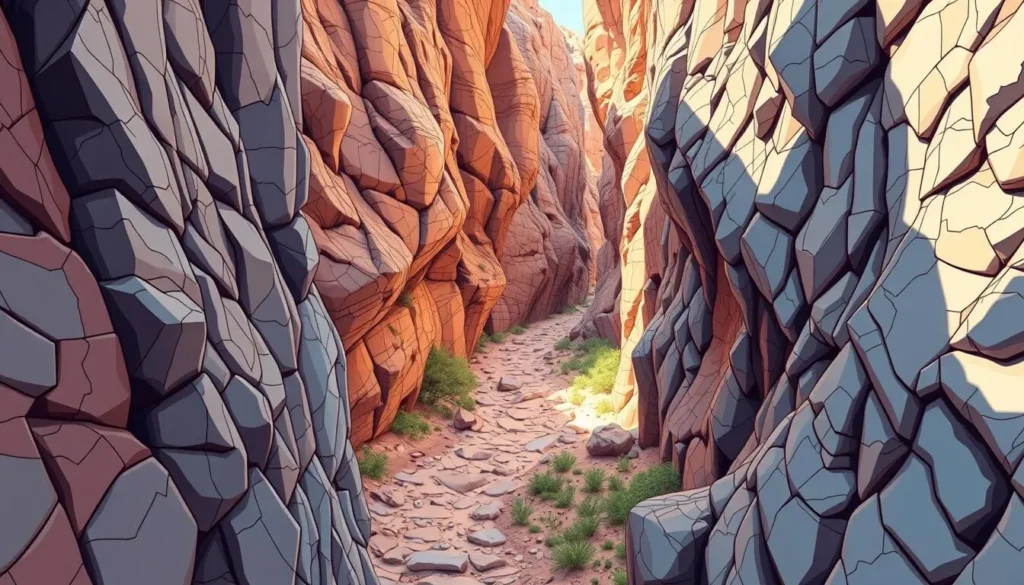
Mosaic Canyon Trail
Mosaic Canyon is a 3.6-mile round-trip trail featuring smooth, polished marble walls created by flash floods over millennia. The trail narrows dramatically, creating a slot canyon experience. For the more adventurous, it’s possible to explore beyond the popular end destination.
Both the Golden Canyon-Gower Gulch Loop and Mosaic Canyon Trail are best hiked in the early morning hours to avoid the heat and to experience the changing colors of the canyon walls as the sun rises. Proper preparation with plenty of water, sun protection, and sturdy footwear is essential, as the terrain can be challenging and there is little to no shade along the routes.
Death Valley’s hiking trails offer an unparalleled opportunity to explore the park’s diverse landscapes and geological wonders. Whether you’re hiking through the golden badlands or navigating the marble walls of Mosaic Canyon, each trail provides a unique perspective on the natural beauty of Death Valley National Park.
Dante’s View: Panoramic Vistas of Death Valley
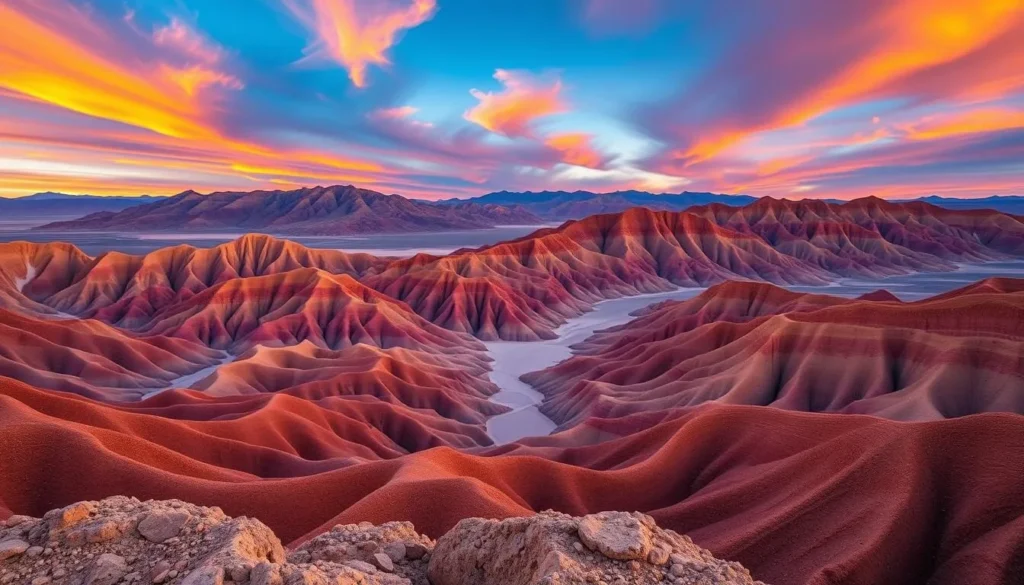
At an elevation of 5,575 feet, Dante’s View presents a stunning perspective on the vastness of Death Valley. This mountaintop viewpoint is one of the best places to visit in Death Valley National Park, especially if you’re short on time. Located about 25 miles from the Furnace Creek visitor center, it offers a unique vantage point over the park’s diverse landscapes.
What You Can See from Dante’s View
From Dante’s View, you can witness the dramatic contrast between the highest and lowest points in Death Valley National Park. You’ll see Badwater Basin 5,758 feet directly below you, a vast expanse of salt flats that stretches as far as the eye can see. On clear days, the view extends to both the highest point in the contiguous United States, Mount Whitney at 14,505 feet, and the lowest point, Badwater Basin at 282 feet below sea level. The surrounding landscape includes the Panamint Range, Black Mountains, and Owlshead Mountains, creating a breathtaking panorama.
Stargazing from Dante’s View
Dante’s View is not only a great spot for daytime viewing but also one of the premier locations for stargazing in Death Valley National Park. Its elevation and distance from light pollution make it an ideal spot to witness the night sky in all its glory. On moonless nights, the view of the Milky Way is simply breathtaking. Additionally, the temperature at Dante’s View is typically 15-20 degrees cooler than on the valley floor, providing welcome relief during the hot summer months.
Unique Geological Wonders in Death Valley
Your journey through Death Valley National Park will unveil a plethora of extraordinary geological features. As you explore this vast and arid landscape, you’ll encounter unique formations that have been shaped by millions of years of geological activity.
Devil’s Golf Course
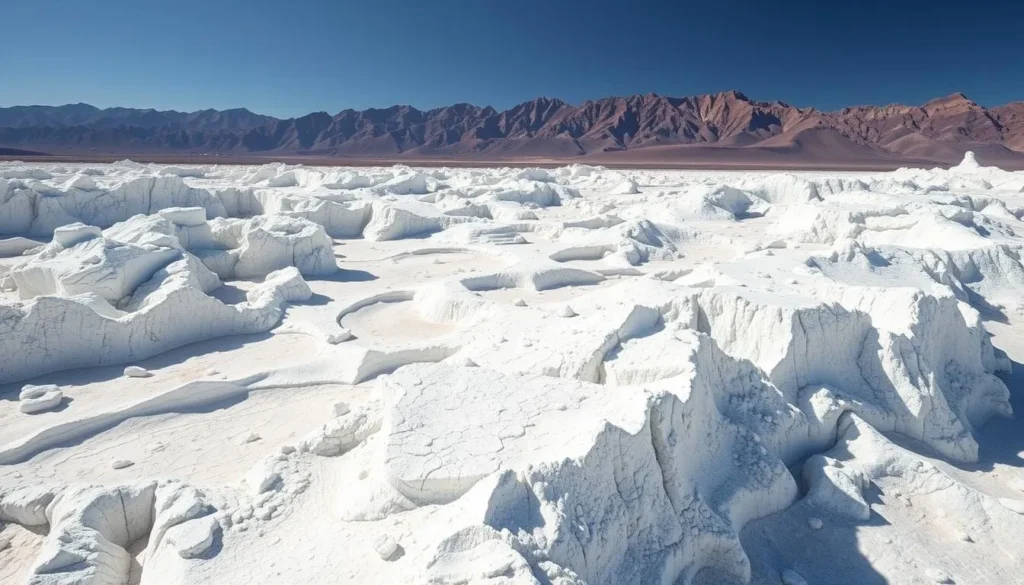
The Devil’s Golf Course is a surreal landscape of jagged salt formations created when an ancient lake dried up, leaving behind minerals that were shaped by rare rainfall and wind into sharp, crystalline spires. Be cautious when walking here, as the salt formations are extremely sharp and can easily cut skin or damage clothing.
The name “Devil’s Golf Course” comes from the saying that “only the devil could play golf on such rough terrain.” This unique feature is a must-see when visiting Death Valley National Park, and it’s located near Badwater Basin, making it an easy stop on your tour.
Natural Bridge Canyon
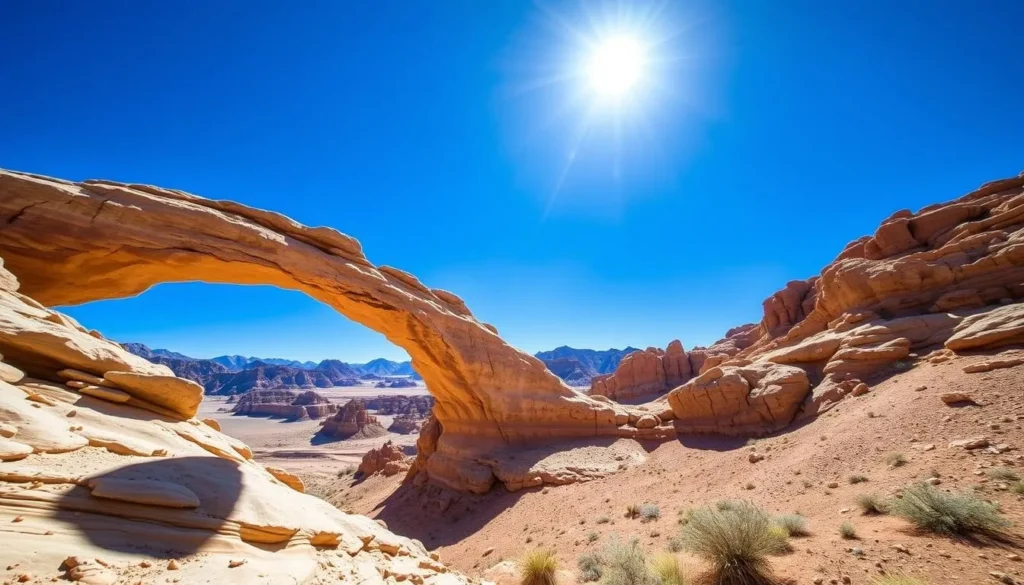
Natural Bridge Canyon is another geological wonder that showcases the park’s diverse landscape. The natural bridge, formed by rushing floods pounding a hole through a rock, is about 0.3 miles from the car park area. This massive rock formation spanning the canyon was created by flash floods eroding the softer rock beneath while leaving the harder top layer intact.
The natural bridge is easily accessible via a 0.5-mile hike up a gravel wash, making it one of the more family-friendly geological attractions in Death Valley National Park. As you explore this area, you’ll gain a deeper appreciation for the geological forces that have shaped this unique landscape.
Both the Devil’s Golf Course and Natural Bridge Canyon are testaments to the incredible geological diversity found within Death Valley National Park. As you continue your journey through the park, you’ll discover many more fascinating geological features that make this a truly unique destination.
Remote Adventures: Racetrack Playa and Sailing Stones
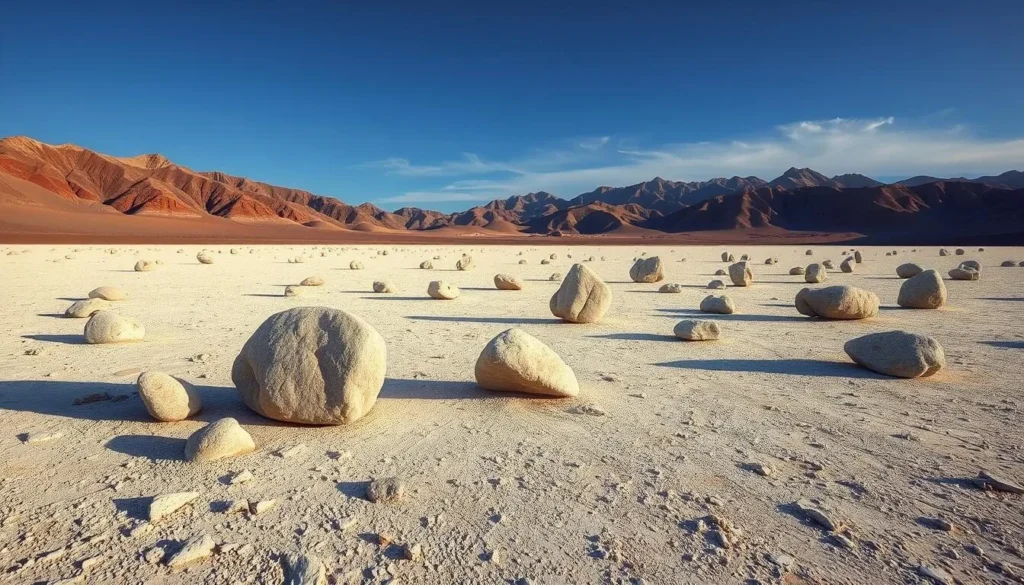
In the heart of Death Valley National Park lies Racetrack Playa, a site of natural wonder and mystery. This remote area is known for its sailing stones, large rocks that seemingly glide across the dry lakebed, leaving behind trails. The journey to Racetrack Playa is an adventure in itself, requiring careful planning and preparation.
The Mystery of the Moving Rocks
Racetrack Playa is home to one of Death Valley’s most mysterious phenomena—the sailing stones that move across the dry lakebed, leaving long tracks behind them without any human intervention. Scientists have discovered that the stones move when thin sheets of ice form during rare winter rain events. As the ice melts and breaks up, light winds can push the ice sheets and the embedded rocks across the playa.
4WD Requirements and Safety Tips
Reaching Racetrack Playa demands a high-clearance 4WD vehicle, plenty of spare tires, and experience driving on difficult terrain. The 27-mile journey on a rough, unpaved road can take about 3-4 hours one-way from Furnace Creek. When visiting this remote area, it’s crucial to bring extra water, food, and emergency supplies, as there is no cell service and few other visitors if you encounter problems.
Darwin Falls: An Oasis in the Desert
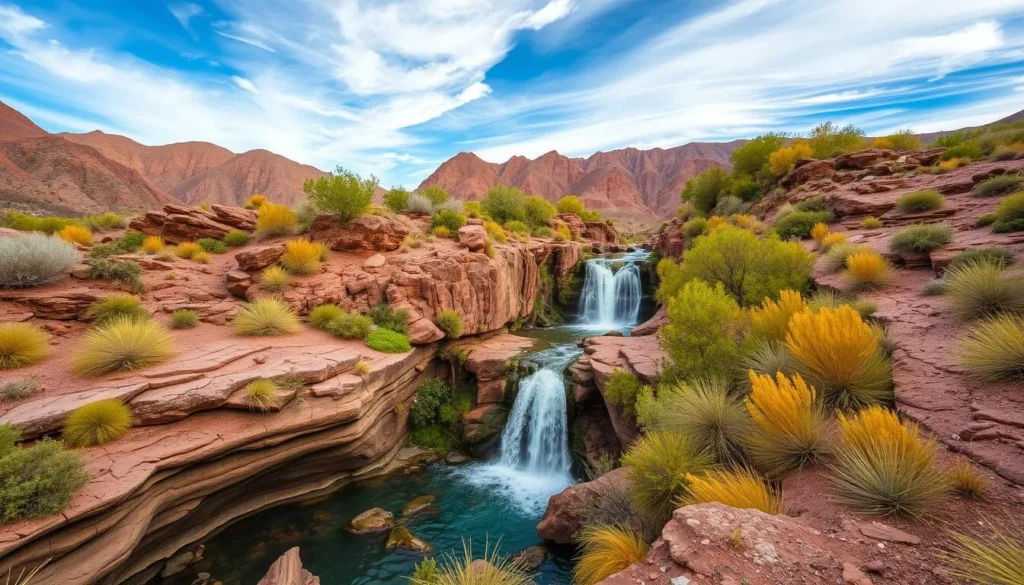
Tucked away in the western edge of Death Valley National Park lies Darwin Falls, a year-round waterfall that defies the park’s arid reputation. This natural wonder is a must-visit attraction within the park, offering a unique experience amidst the desert landscape.
Hiking to Darwin Falls
The hike to Darwin Falls is approximately 2 miles round trip, following a stream bed through a canyon that becomes increasingly verdant as you approach the falls. The trail is relatively easy, making it accessible to a wide range of visitors. As you hike, the sound of flowing water grows louder, and the scenery transforms into a lush oasis.
Wildlife Around Darwin Falls
The area around Darwin Falls supports abundant plant life, including cottonwoods, willows, and various riparian species. This vegetation provides habitat for birds and small animals, creating a thriving ecosystem that contrasts sharply with the surrounding desert. As you explore the area, keep an eye out for the diverse wildlife that calls Darwin Falls home.
Darwin Falls is located near Panamint Springs on the western edge of the park, requiring a separate trip if you’re staying in Furnace Creek or Stovepipe Wells. However, the unique experience and breathtaking scenery make it well worth the journey. With its shrubbery setting and plentiful shade, Darwin Falls makes for a memorable picnic hike, so be sure to bring some hiking food and enjoy the serene atmosphere.
Ubehebe Crater: Volcanic History
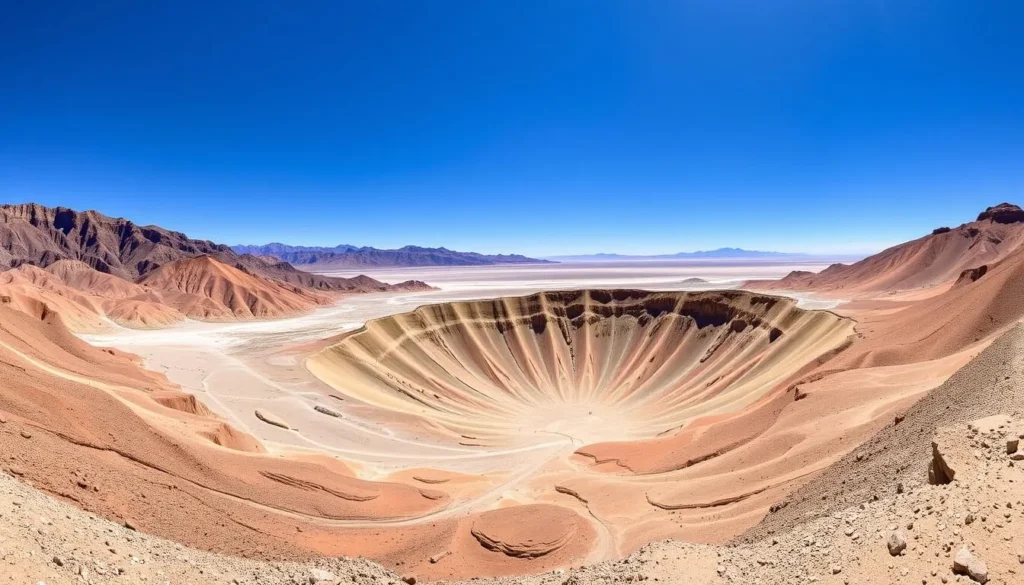
Ubehebe Crater, a volcanic marvel in Death Valley, is a must-visit attraction for anyone interested in geological wonders. Located in the northern part of Death Valley National Park, this massive crater is approximately 600 feet deep and half a mile wide.
Formation of the Crater
The Ubehebe Crater was formed around 2,000 years ago when magma rose from the depths and encountered groundwater, resulting in a massive steam explosion. This explosion scattered cinder and ash over the surrounding landscape, creating the dark, volcanic material that starkly contrasts with the typical desert terrain.
The crater’s formation is a significant geological event that showcases the volcanic history of the area. The explosion that created the crater was so powerful that it scattered volcanic material for miles around.
Hiking Around and Into the Crater
Visitors to the Ubehebe Crater have several hiking options. You can take a short walk to the viewpoint, hike down into the crater (though climbing back out is strenuous), or walk around the rim on a 1.5-mile loop trail. The rim trail offers panoramic views of the colorful layers inside the crater and the surrounding Death Valley landscape.
As you hike around the crater, you’ll also have views of several smaller craters, including Little Hebe. The Ubehebe Crater is a great spot for those looking to hike and explore the unique geological features of Death Valley National Park.
Where to Stay in Death Valley
When planning your trip to Death Valley National Park, choosing the right accommodations is crucial for a comfortable and enjoyable experience. Death Valley offers a range of lodging options to suit different preferences and budgets.
Furnace Creek Accommodations
Furnace Creek is the largest and most central location within Death Valley National Park, offering the most developed accommodations. You can choose between The Inn at Death Valley, a historic luxury hotel with a spring-fed pool, and The Ranch at Death Valley, a more affordable option with motel-style rooms.
The Inn at Death Valley provides a luxurious experience with its elegant rooms and excellent amenities, while The Ranch at Death Valley offers comfortable accommodations at a lower price point. Both options are conveniently located near major attractions like Badwater Basin and Golden Canyon.
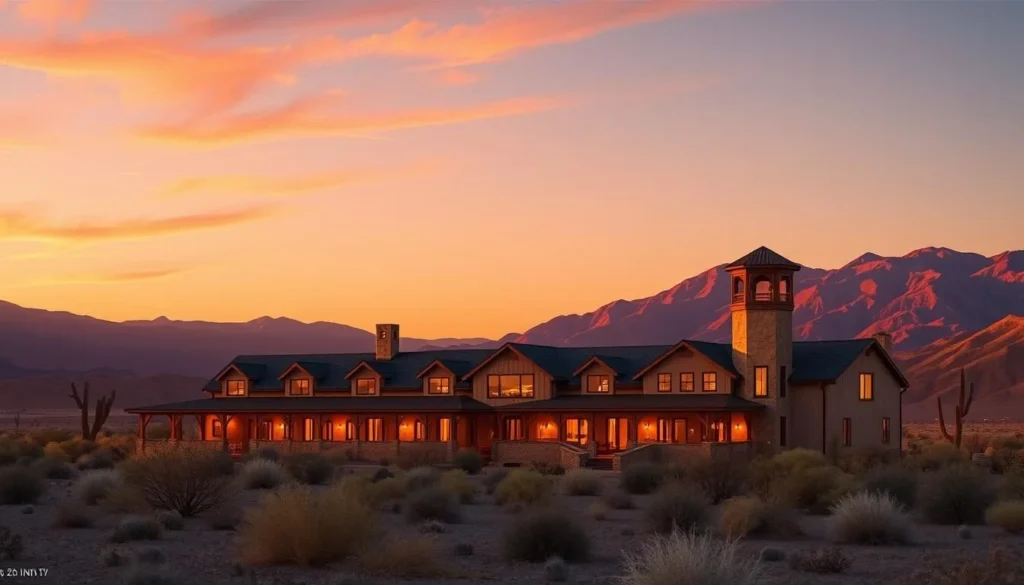
Stovepipe Wells and Panamint Springs Options
If you’re looking for a more rustic experience, Stovepipe Wells Village and Panamint Springs Resort are alternative options. Stovepipe Wells provides a motel, restaurant, saloon, general store, and gas station, and is located near the Mesquite Flat Sand Dunes and Mosaic Canyon.
Panamint Springs Resort, on the western edge of the park, offers simple rooms, a restaurant, campground, and RV sites. It’s the closest accommodation to Darwin Falls and Father Crowley Vista Point, making it an ideal choice for those exploring these areas.
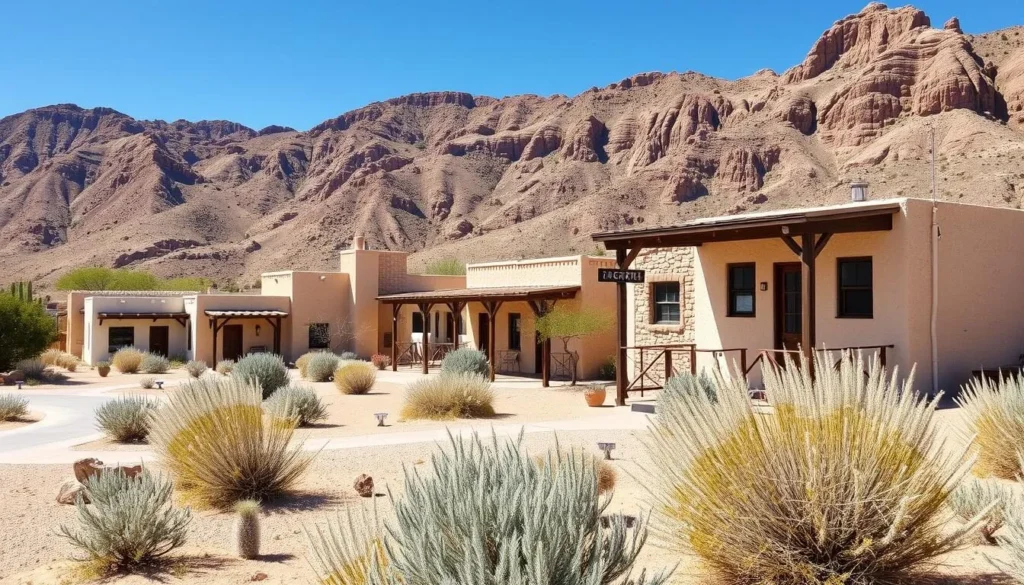
For those on a budget, Death Valley has nine campgrounds throughout the park with varying amenities and seasonal availability. Additionally, free backcountry camping is permitted in certain areas for those seeking a more remote experience.
Seasonal Attractions in Death Valley
From the vibrant wildflowers of spring to the comfortable hiking temperatures of winter, Death Valley National Park has seasonal attractions that are not to be missed. Whether you’re looking for a unique landscape or an exciting activity, the park’s diverse seasons offer something for everyone.
Spring Wildflower Blooms

Spring in Death Valley brings the possibility of wildflower blooms, with the rare “superbloom” occurring approximately once per decade when winter rains are perfectly timed and temperatures are ideal. Even in non-superbloom years, you can find wildflowers in the park from February through June, with different elevations blooming at different times.
Winter Activities in Death Valley
Winter is one of the best seasons for visiting Death Valley, with comfortable daytime temperatures perfect for hiking and exploring areas that would be dangerously hot in summer. Winter also brings the possibility of rare rainfall, which can create temporary lakes on the valley floor and dramatically transform the landscape for brief periods.
Fall and winter visitors benefit from smaller crowds, more availability at accommodations, and the chance to hike in comfortable temperatures while still enjoying the stark beauty of the desert landscape.
Conclusion: Making the Most of Your Death Valley Experience
Death Valley National Park, spanning an impressive 5,270 square miles, is a vast and captivating destination that requires careful planning to explore effectively. To make the most of your visit, it’s essential to be prepared for the extremes of this unique landscape.
Plan carefully and bring plenty of water, sun protection, and a detailed map. The park’s diverse landscapes and experiences can surprise even seasoned visitors, but services are limited, and distances between attractions are substantial.
Consider the season when planning your trip, as your experience will vary dramatically between the mild winter months and the extremely hot summer season. Focus on the highlights that interest you most and save some attractions for a return trip to truly appreciate what Death Valley has to offer. Whether you’re drawn to the salt flats, colorful canyons, or mysterious moving rocks, Death Valley National Park will leave you with unforgettable memories.
The above is subject to change.
Check back often to TRAVEL.COM for the latest travel tips and deals.
